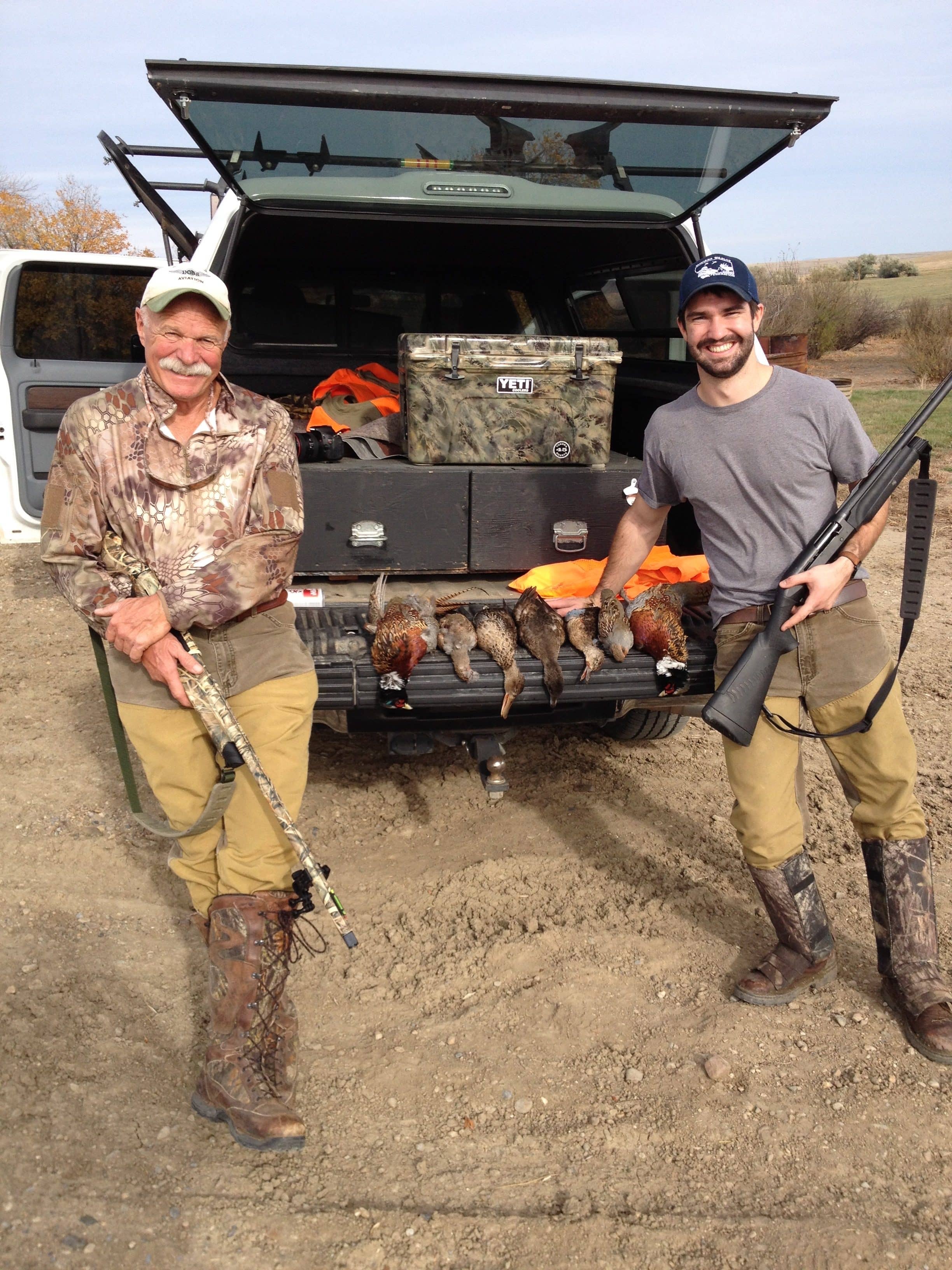
The author (R) and his father celebrate a mixed bag hunt many years after their first forays into the field together. DEO Photo by John Bradley.
By John Bradley
My dad recently told me a story about his little brother who, on his first gun season in Southern Minnesota, was dropped off in a tree grove before sunrise, given a couple slugs for his shotgun, and was strictly told to sit here and wait until someone came to get him. When the rutting buck came running through, he raised his gun and “click.” Unsurprisingly, my then 12-year-old uncle was ill-prepared, not having put a slug in the chamber. There was a good outcome, however, this event influenced both my uncle and my dad in how they mentored their own children into hunting. I shot my first deer not too far from where my uncle was dropped off, but with my dad in the stand with me. In fact, my first couple of seasons were spent with my dad guiding me into the sport and ensuring that I was set up for success.
With the deer gun season just a couple of weeks away, here is a brief guide to mentoring beginner hunters to positive outcomes that will help them fall in love with the sporting tradition.
Hit the Range
Before any actual hunting, newcomers must gain the skills needed to be effective in the field. Depending on the student’s level of training, they may need full-on gun-safety and basic handling lessons. Rifle shooters may need instruction in shooting technique, especially when firing from field positions.
In addition to safety and handling basics, wingshooters may need coaching on mounting, footwork and swing-through. Clay birds are ideal for training, and sporting clays can be especially valuable because of the variety of targets that simulate different kinds of hunting. If you have a safe place to shoot, a handheld thrower can zing clays for useful practice. The first step is to shoot with your beginner or refer them to qualified instruction. Only when they can demonstrate competence and proper gun safety on the range are they ready for the real thing.
Lead by Example
The tried-and-true method for training new hunters is for them to accompany parents or grandparents, strictly as an observer at first, leveling up to full participant when the time is deemed right. This is the norm among family groups and where possible there is still no better way. But with more and more hunting recruits coming as adults, it suits us to accommodate their natural inclinations to get right in on the action.
A solution to getting them into the action right away is a preseason visit to your hunting spot. When that can be arranged, walk through the woods or fields, look for sign, try to spot wildlife—the animals you will be hunting and others. Climb into the stand or blind you will be using. Scouting it out is a great way to orient budding partners before the action and pressure of the real thing factor in. A dress rehearsal helps them to break-in new boots and get used to their hunting clothes while learning to walk quietly and use their eyes and ears like a predator.
It’s also a time to practice and learn using some of the tools of the trade – binoculars, rangefinders, game calls, etc. These tools can be intimidating for first-time users and so instruction is in order. Be patient and encourage the new hunter to practice on their own. The point here is that any ground you guys can cover in a warm-up session will contribute to making the hunt safer and more productive.
Keep it Simple
Avoid starting with hunts that are overly challenging—those requiring lots of time, money, physical exertion, and expensive equipment—as well as situations likely to require split-second decisions and follow-through. Pursuing game that is abundant and easily located is the ideal scenario. Though hunting wild animals is never a given, some outings tend to be more predictable than others, thus giving newbies a better chance to process what is happening and to prepare to make a good shot. Game that comes to the hunters—deer from stands, spring turkeys, and waterfowl over decoys—gives beginners prime opportunities to be safe and successful.
A pre-hunt gear review is another important step. Make sure ammo that matches the appropriate firearm – which should have been used in range sessions – will be in use. If you can, loan them things like clothing, optics, a stool, perhaps even an easy-to-use tool like a deer grunt tube or push-pin turkey call. Footwear is important and not something easily shared, so well beforehand, help your trainee understand what is needed. Cold, wet feet can ruin a hunt and douse the will to stick with it.
Respect the Game
While it’s entirely possible to gain the skills needed to kill lots of game, if a hunter does not also develop respect for the sport, for fellow hunters, landowners, and for the animals, they’re missing out on one of the best parts of hunting. We owe to beginners an explanation of why we do the things we do: why we practice fair chase, shoot only when one can make a quick humane kill, and why we honor a killed animal with gratitude and respect. Ethics all hunters should embrace. While it isn’t possible to force one’s values on anyone else, we can and should share what makes this outdoor heritage vital to our lives and so many others.
Lastly, and maybe most importantly, we need to pass along that hunters are dedicated, on-the-ground conservationists and that wildlife management through hunting is the proven best way to ensure the continued existence of the game species we pursue.
John Bradley is the Executive Director of the North Dakota Wildlife Federation and a Dakota Edge Outdoors contributing writer.
